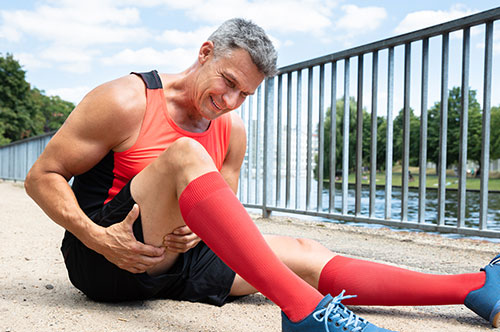Written by Chris Teh
Hamstring strains are a common lower limb sporting injury that also have a high re-injury rate. Typically, these injuries are seen in sports that involve quick acceleration, or positions which put the muscle on a large stretch. A hamstring strain usually takes between 3-6 weeks to recover, but in some cases it may be shorter or longer depending on the severity of the injury. Rehabilitation to strengthen the injured muscle is the most important thing you can do when you have a hamstring strain as this is your best chance at preventing it from recurring time and time again

Mechanisms of injury for a hamstring strain
There are two main mechanisms of injury. The most common (accounting for ~60% - 70% of incidences of hamstring strains) occurs during high-speed running and the second mechanism involves excessive lengthening of the hamstrings such as high kicking, slide tackling or performing front splits. Strains that occur during high-speed running usually involve the lower portion of the hamstring, whereas strains that result from excessive lengthening tend to affect the upper portion of the hamstring.
Research tells us that strains resulting from high-speed running usually present with greater initial impairment than strains that result from excessive lengthening. However, despite the greater impairment of high-speed strains, they usually require a shorter rehabilitation period than a lengthening strain. Regardless of the mechanism of injury, both types of hamstring strains are rehabilitated in a similar manner.
Risk factors for a hamstring strain
There are multiple risk factors when it comes to identifying those who are at a greater risk of sustaining a hamstring strain. Below are 6 factors that may increase your chance of injury.
- Previous injury to hamstring
- Advanced age
- Reduced eccentric hamstring strength
- Deficient hamstring to quadriceps strength ratio
- Poor flexibility
- Muscle fascicle length (a fascicle is a bundle of muscle fibres grouped together for extra strength and the ability to exert more force)
History of hamstring strain and advanced age can’t be changed, but the remaining factors can be modified and should be addressed to minimise the chance of sustaining an injury.
How to rehabilitate a hamstring strain
here is no evidence to show one singular conclusive method/program that is the best for rehabilitation of hamstring strains. However, there is a general consensus on key elements that should be included in a rehabilitation program that will lead to optimal results. These elements include a combination of strengthening, trunk stability/control, neuromuscular control and sports specific training. It is important that all of the above elements are addressed before any athlete returns back to high-level competition as failing to do so can increase the risk of re-injury.
The rehabilitation of a hamstring strain can be broken down into various “phases” that are progressed as the athlete achieves certain goals.
- Phase 1- light running drills, stretching and strengthening exercises for the hamstring. Once goals have been met, move into “phase 2”
- Phase 2 - addition of change of direction drills and more difficult strengthening exercises.
- Phase 3 - weight training and sport-specific drills and eventually return to sport.
Hamstring strain prevention
The old saying “prevention is better than a cure” rings very true when it comes to hamstring strains. There is strong evidence in the literature that supports performing exercises to prevent the occurrence of hamstring strains. Currently, the number one preventative exercise is the Nordic hamstring curl. Research has shown that performing this specific exercise during pre-season training can minimise the risk of sustaining a hamstring strain by up to 50%. Hence, it is extremely crucial that this exercise be considered as part of training on an ongoing basis.
References
Askling, C. M., Tengvar, M., Tarassova, O., & Thorstensson, A. (2014). Acute hamstring injuries in Swedish elite sprinters and jumpers: a prospective randomised controlled clinical trial comparing two rehabilitation protocols. Br J Sports Med, 48(7), 532-539.
Brukner, P. (2015). Hamstring injuries: prevention and treatment—an update. Br J Sports Med, 49(19), 1241-1244.
Buckthorpe, M., Wright, S., Bruce-Low, S., Nanni, G., Sturdy, T., Gross, A. S., ... & Gimpel, M. (2019). Recommendations for hamstring injury prevention in elite football: translating research into practice. Br J Sports Med, 53(7), 449-456.
Erickson, L. N., & Sherry, M. A. (2017). Rehabilitation and return to sport after hamstring strain injury. Journal of sport and health science, 6(3), 262-270.
Ribeiro-Alvares, J. B., Marques, V. B., Vaz, M. A., & Baroni, B. M. (2018). Four weeks of Nordic hamstring exercise reduce muscle injury risk factors in young adults. The Journal of Strength & Conditioning Research, 32(5), 1254-1262.
Sherry, M. A., & Best, T. M. (2004). A comparison of 2 rehabilitation programs in the treatment of acute hamstring strains. Journal of Orthopaedic & Sports Physical Therapy, 34(3), 116-125.
